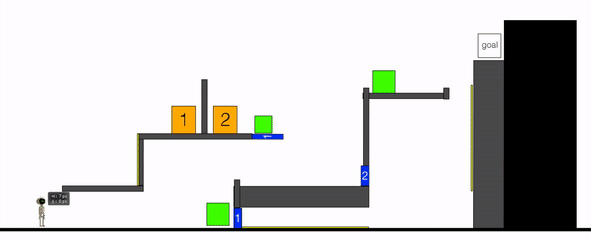
Gameplay Overview
Silver Lining is a 2D side-scroller narrative-driven puzzle-platformer game that follows the story of a lone robot in a deserted post-apocalyptic world where humans have gone extinct. After a rough awakening, the robot finds itself in a pit, alone in this meaningless world. Pondering the purpose of its existence, it decides to begin a journey traversing the world to find a purpose for its existence. Although the robot has to face many obstacles, puzzles, and challenges throughout its journey, it doesn’t give up in hopes that it could find a silver lining in this meaningless world.
Trailer made by me!
Roles, Responsibilities and Contributions
I had the responsibility of leading a team of 7 individuals over a three-month period. As the sole designer, I assumed the role of lead designer and took charge of project lead and management. This experience marked my first time in a project management position in a large scale project, and I learned a lot, growing both as a project manager and a designer.
My goal for this project was to create an atmospheric narrative-driven game without using any dialogues or text, using only environmental storytelling, focusing more on the cinematic experience of the game, using no cutscenes and dialogues.
Design Process
The aspect of contribution that I'd like to emphasize the most is my work on the level design, most importantly on how I communicate my ideas with the level with the rest of the team. My level design process for this project is split into 4 steps:
Step 1
The first step of the process is identifying the gameplay objective for each level. The gameplay objectives serves as the purpose the of level. For example, in our first level, the player would have no idea what to do as it is a game they are unfamiliar with. Therefore as a tutorial level, the gameplay objective for this level was to introduce the controls, introduce the main puzzle mechanics, introduce visual cues and introduce the fail condition. These gameplay objectives outlines what should be in the level, which is crucial in figuring out the layout and set piece of the level.
Step 2
With the gameplay objective in hand, I move on to the second step, which is to storyboard the level. The storyboard details each individual steps that the player needs to take in order to complete the level with images and description. I use the storyboard as a way to communicate to my team and help them understand each individual beat of the level. Here is an example of the storyboard I made for our first level:

Step 3
After completing the storyboard, I can start blocking out the level using photobash. By using this method, I can identify what fits in the environment, which helps me list down assets required for the artists to create. The artists could also use the image as a reference during their asset creation process. Here are examples some examples of the blockouts:


I use this same process to design puzzles for this game. I create the block-out of different iterations puzzles using simple shapes in Photoshop and to communicate how the puzzle works I created a simple video to communicate the idea of the puzzle.

This method was time consuming and only used because the puzzle mechanics were not implemented yet. In future levels where the mechanics were already implemented, the puzzle block-outs and demonstration were done in engine like in the following:


Step 4
The final step is to import all the assets created and dress up the scene in engine with the assets provided. Here is the final look of the level:

That concludes my reflection on this project, thanks for reading!
